By Jock Elliott, KB2GOM
Hang out any place online where shortwave listeners gather, and you won’t have to wait long before you hear something like this: “I recently moved to a condo, apartment, or house where there is a home-owners association. Listening conditions are pretty rotten, and I cannot string up outdoor antennas because of physical constraints or HOA rules . . . help!”
Ever since I got back into SWLing nearly two years ago, I have faced similar issues, as I explained here. During that time, I have frequently read that amplified small loop antennas work pretty darn well, and that has piqued my curiosity.
A couple of days ago, the good folks at MFJ (an SWLing.com sponsor) sent me their MFJ-1886 receiving loop antenna. Weighing just 2.5 pounds, the 1886 is a 36-inch-diameter loop of aircraft-grade with an amplifier attached in a weatherproof enclosure. Designed for receiving only, it covers .5 to 30 MHz.
The fit and finish of the 1886 is, in my opinion, great. Looking at the seamless loop and the molded enclosure for the amplifier, I have no reason to doubt what MFJ has to say about it: the MFJ-1886 is weather-sealed, very ruggedly constructed, and mechanically stable under all weather conditions. In fact, you can mount it permanently on any inexpensive TV rotor and direct it from the comfort of your shack . . . it also installs easily on a tripod or handheld mast for portable use.
Important: the 1886 loop is a directional antenna. If you are looking through the open area in the middle of the loop (the flat side, if you will), you are looking in the direction in which the antenna tends to null out signals . . . in both directions. If you are sighting along the edge of the loop (at right angles to the flat side), that is the direction in which the antenna produces the most gain. As a result, you will get the most utility out of the 1886 if you can mount it in such a way that you can rotate it to maximize gain and/or null out noise or interfering signals as needed.
Since my mission was to test the 1886 indoors, I wrapped some parachute cord around the loop and hung it from a screw attached to the top of a window frame. Obviously, I am not getting the most from the 1886 by keeping it in a fixed position (in fact, I was getting maximum gain to the northeast and the southwest), but I did experiment with the antenna hanging from the ceiling so that it could rotate, and I did, indeed, find that signal strength rose and fell as the antenna changed position.
To see how the 1886 performed, I used my Grundig Satellit 800 as a test bed. The Satellit 800 has three different antenna inputs: a wire input, to which I attached the 50-foot horizontal room loop (an indoor antenna which runs around the perimeter of my radio room at about seven feet in the air); a coax input, to which I attached the MFJ 1886 loop, and the four-foot whip antenna that is built into the Satellit 800. By reaching around the back of the radio and sliding the antenna selection switch, I could easily change from one antenna to another and compare the 1886 loop with the whip and the horizontal room loop at various frequencies and settings.
Setting up the 1886 loop is super easy. First, attach a length of coax to bottom of the amplifier box. (The 1886 uses SO-239 connectors.) Attach that coax to the top of the Bias Tee. The Bias Tee supplies power to the amplifier mounted on the loop using the coax and without introducing noise. Run another piece of coax from the bottom of the Bias Tee to the receiver, and, finally, plug the power supply into the Bias Tee and the house power where you are using the antenna.
Operating the 1886 is even easier. To hear the signal from the loop without amplification, leave the Bias Tee switch in the OFF position. To hear the signal with amplification, just slide the switch to the ON position. That’s all there is to it. There are no fussy adjustments to make.
So how did the 1886 loop perform? Very well, thank you. In all cases, it clearly outperformed the Satellit 800’s whip antenna, providing more signal with less noise. When pitted against the 50-foot horizontal room loop wire antenna, the 1886 typically delivered more signal and less noise. In a few instances, the horizontal room loop was equal to the 1886 loop in terms of signal strength and low noise. In no cases, did the horizontal room loop outperform the 1886 loop.
Tuning around a bit, I found myself listening to a ham from Spain working DX on the 15 meter band. A little further up the band, a ham from central Bulgaria was dealing with a pile-up of U.S. hams trying to reach him. Of the three antennas options I had on the Satellit 800, the 1886 loop offered the most pleasant listening with more signal, less noise.
Then I tried the 1886 with a couple of my portable shortwave receivers. The Bulgarian ham was still on the air and was marginal on one portable and not hearable at all on the other on their native whip antennas. With the 1886 loop connected, however, the Bulgarian was clear and easy to hear. And – thanks to a ham friend who whipped up an additional coax “jumper” with amazing speed – I tried the 1886 loop with the MFJ 1045C active preselector and found the two made a very potent combo for pulling signals out of the mud.
So, would I recommend the MFJ 1886 Receiving Loop for a would-be HF listener who lives in a condo, apartment, or house with antenna woes? Absolutely . . . even if you have to hang it flat in front of a window. And if you can find a way to mount it so that it can be rotated, even better. (Someday, I hope to try the 1886 outside mounted on an inexpensive TV rotator. For now, there simply isn’t room in my cramped radio space.)
Of course, the performance at your location will depend on the conditions where you live. Nevertheless, I found the MFJ 1886 Receiving Loop to be easy to set up, easy to use, and effective.
Click here to check out the MFJ-1886 Receiving Magnet Loop Antenna at MFJ.
Suggestions for MFJ: offer a kit or accessory that would be make it easy to set the 1886 on a desk or table. Likewise a kit or accessory that would facilitate using the 1886 on a camera tripod seems like a good idea.
Additional note: The SWLing forum is a great place for discussing all things related to shortwave listening.

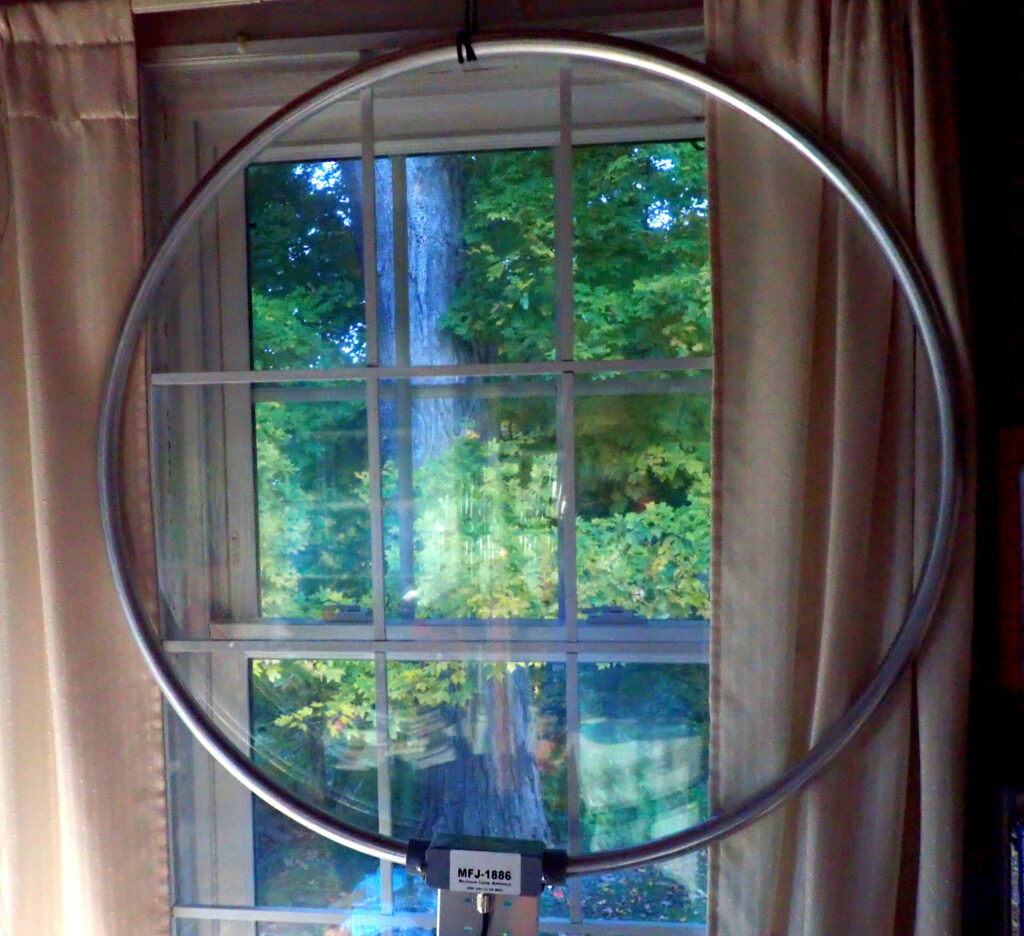
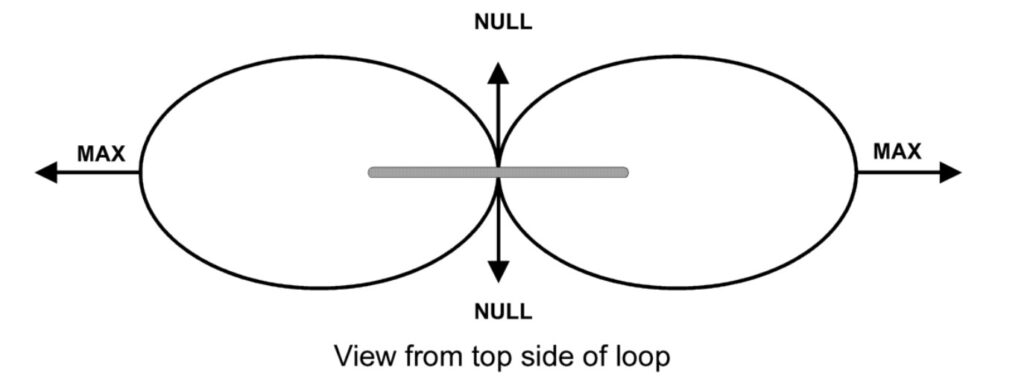
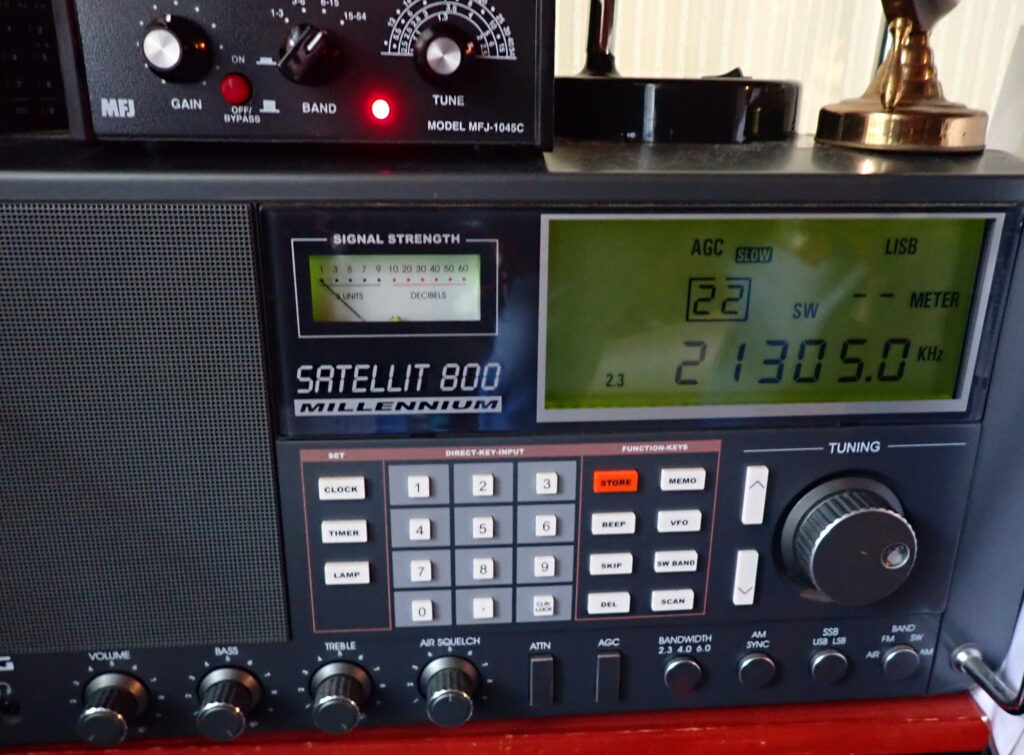
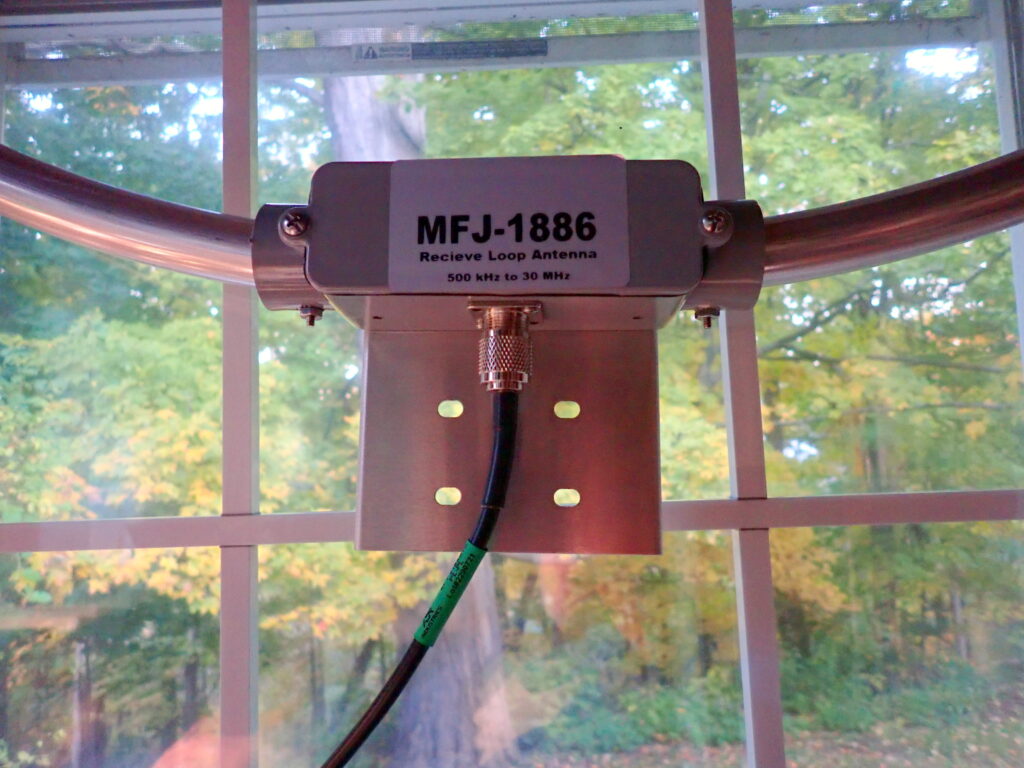
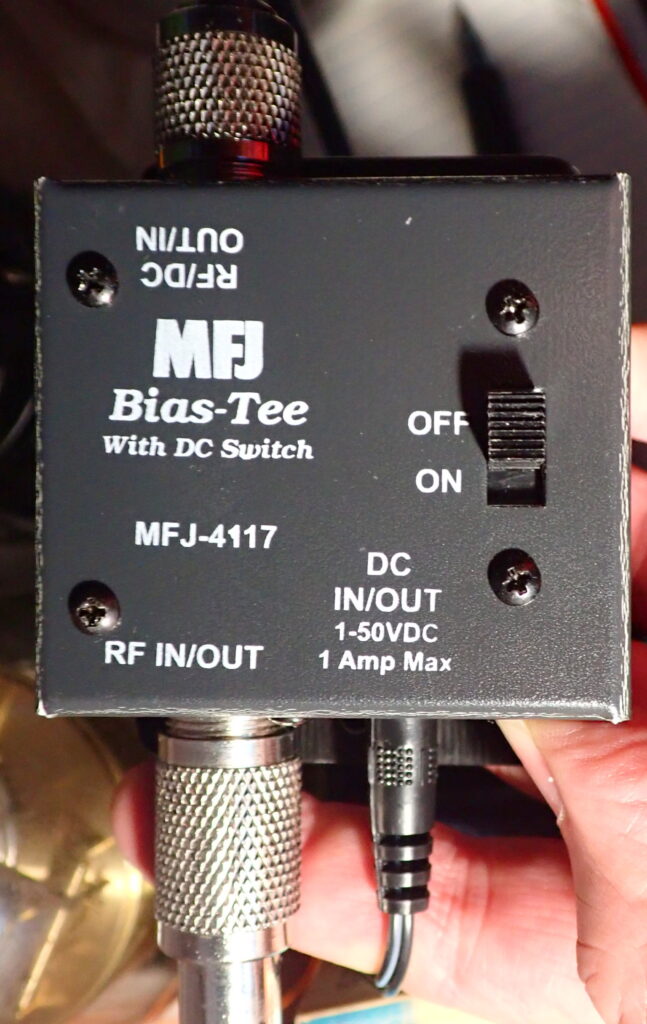
It works very well on AM broadcast band . . . very well, and it is rated for indoor or outdoor use.
How does this work on the mw am broadcast band? I need a low noise good DX antenna that can be used indoors and out. Thank you for any information
Would the RX side of the MFJ-1786 have equivalent RX performance as this MFJ-1886?
Jerry,
Unfortunately, I don’t know since I have not compared the two.
Cheers, Jock
I see this post is a few years old but it just popped up on my feed today, and since I’ve been experimenting with a home-made loop antenna I was interested to read your comments about this one. But what I especially wanted to hear about you didn’t mention — namely the difference in performance of the loop with and without the amplifier turned on. I would expect the amp to add noise and volume but not necessarily a better quality signal. What is your experience with/without the amp?
Also, since I happen to install TV antennas as a sideline business/hobby I was particularly interested in your comments about using ‘an inexpensive TV rotor’. I would definitley like to know who sells these inexpensive TV rotors.
Jim,
Inexpensive TV rotor — something like this: https://www.amazon.com/AUDIOVOX-Remote-Antenna-Rotator-VH226F/dp/B008468PWC/ref=sr_1_3?dib=eyJ2IjoiMSJ9.U-BdsRAntakqVQvtoie_MD5lXBTgs16N9nQDpMRk9diwMjlWNbndkjbX2E_PORjWs1qrgkikxWDZwWvR9mA8eUrAeGT7WtBKMPQz3LXTUM3PwBbZ6SRO6QYKibxaNx5hrQ0qAlMPKfPPl2pgsFRR19lVbLZPIQcOm_1s9yZA2xKXSP8RFqfUSRJmmzfRFDalIgRmPNKbmCnDzD7-zHpOw0OAri7YFwC_ocivK4whdto.eF-y9kTSwXUDk1L7gzQyhL1Pl6l-eND-kq4VR-o9Ksg&dib_tag=se&keywords=tv+antenna+rotor&qid=1709550588&sr=8-3
As to the difference with and without amp, on 1500 (MW) on stations 300 miles away, the difference is night and day . . . from you can barely tell that there is some modulation in the background to a fat S7 signal. Sometimes on higher frequencies, you can tell that the amp introduces noise, but the signal-to-noise ratio is improved at the same time.
On the time station on 3330, my horizontal indoor room loop (50 ft of wire) is noisy, but I can hear the signal. With the 1886 loop with the amp off, I can faintly hear the signal with little noise, but the amp engaged, there is more noise but also much more signal.
I hope this helps
Cheers, Jock
Jim,
I just ordered an RCA antenna rotator from Amazon for $121 for my MFJ-1786 Mag Loop. Walmart sells for ~$126. They get good reviews and apparently many hams use them for small antennas – loops or small 4 or 5 element yagis.
how high is your mfj mounted and how about dx?
Thanks
HOW DOES IT WORK ON 160 METERS??
Chris,
It works very well. I just checked this AM and found a conversation that I could hear clearly on 1.970 MHz with the 1886 loop that I could not hear at all with my 50-foot horizontal room loop.
Cheers, Jock
I’d like to see the 1886 compared to the MLA 30+ in an indoor setting.
Mike G,
Sorry, I don’t own the MLA 30+.
Cheers, Jock
Jock,
Did you consider testing the antenna placed in the horizontal plane? Certainly directionality would be lost, but wonder about noise and signal strength.
Dennis,
I did not . . . in fact, I didn’t even think of it . . . but it is an intriguing idea.
Maybe someone else has tried it and can comment.
Cheers, Jock
My 1886 arrived, and i was able to test the antenne extensively to compare with my Wellbrook (outside) wich is more then 10 years old. The 1886 is mounted on a tripod inside, at exact the same height as the Wellbrook (3th floor) with the benefit of that rotating is possible, but there is only a small effect of that..
I used my Icom 8500/ Fairhaven RD500/ NRD535D for the test, connected by an antenna switch to easely compare both antennas.
Funny enough both are comparable, although the Wellbrook delivers a bit more gain at the higher bands but it’s Not spectacular (1 db or less). On the 8 MHz band there was a rattle on the 1886 that was not on the Wellbrook but for the rest both antenna’s delivered the same. A Wellbrook costs twice the price of the 1886, although at the moment Wellbrook suspended delivery to Europe because of stupid Brexit rules…
So, my conclusion is: the 1886 is worth its money and will service many swl’s for an affordable price…
Feel free to ask if you want to know more,
Regards, Bjern NL6001 @ JO22OJ
Bjern,
That is great to hear! Thanks very much for your comments.
And, by the way, that’s a nice receiver collection you have.
Cheers, Jock
Thanks Jock, I wasn’t bragging (is that the right word?) but they are only my bedside receivers, part of my collection after 55 years of shortwave listening..I love radio since getting an old telefunken tube receiver from my grandfather who was a pioneer back in the 1920’s…never stopped searching for the best receivers…as a result these are my favourites….
Cheers,
Bjern
Would the receive performance of this 1886 be comparable to that of the MFJ-1786 RX/TX antenna? I have one on order to finally get on air on HF.
Bjern,
I look forward to your results, and you did NOT offend me . . . all good here.
Cheers, Jock
Gutters are not usually grounded, and can make an effective stealth swl antenna, connect it with about 20 ga. Copper magnet/coil wire. Also, I have run the same wire as a stealth antenna outside my apartment window almost 50 feet long, glued along the loweer edge of the wooden siding. An aluminum screen frame is an effective loop antenna, connect to it, if you have two windows, connect to both. Different size screen frames work better for different bands. If you are on an upper floor, hang a section of magnet wire with a small weight out of the window. For the weight, use a small rubber ball, an inch or two diameter, painted the same color as the wall. Reel it in when not being used. Get creative where you can stealthily glue the long, fine wire outside too, use clear silicone sealer.
Timinator,
The business of trying to capture signals when facing restrictions is a tough one, and your ideas merit serious consideration. I bet some folks will put them to good use.
Thanks for your comments.
Cheers, Jock
Thank you much, this is great info. I’ve been looking for a good explanation of the reception pattern for magnetic loop antennas for some time. This is the best one I’ve seen. My YouLoop is mounted in a western facing window. I was always wondering why I was able one pick up SW stations to the south and north so well. Now I know.
Btw, I bought a second YouLoop and tried mounting it perpendicular to the first. But I get so much RFI from my apartment and those of my neighbors that it is not useful. I probably should consider the filtering systems mentioned in the comments. Ah, there’s always something…?
John,
Thanks for the kind words.
Yup, “there’s always something” , , , made me smile!
Cheers, Jock
I’m a bit confused…hanging the 1886 parallel to a window result in having the null looking through the window…wat is the point of that then?
I use a Welbrook Ala1530 for several years now, outside at approximately 6 meters high without a rotator…will a 1886 on a tripod inside the house on the thirt floor outperform my Ala1530?
Regards, NL6001 @OJ22OJ
Bjern,
“hanging the 1886 parallel to a window result in having the null looking through the window…wat is the point of that then?”
The point is to offer some hope to people who are in a situation where they cannot use an outdoor antenna. If you are living in an apartment or condo or house where there are homeowners association restrictions, it may be that the best you can do is to hang a loop flat against a window. As I stated repeatedly in the post, that is not an optimal setup. But it still delivers, in my estimation, impressive performance compared with the whip on my Grundig Satellit 800 or my 50-foot indoor room loop.
As to your second point –” will a 1886 on a tripod inside the house on the thirt floor outperform my Ala1530?” — I have no idea, but from what I have read, the Wellbrook is an excellent antenna.
Jock, I didn’t Ment to offend you and I respect your answer, but what I ment was normally an antenna benefits from being close to a window for obvious reasons. In this case it will do no good because the “null” blocks the benefit from hanging close to your window…and will not permit you to rotate the 1886..sorry English is not my native tongue, I hope you understand what I try to say..
BTW, an 1886 is on it’s way, so I can answer my last question myselves 🙂
I will let you know what the results are..
Regards,
Bjern NL6001
One recommendation that I would have is pairing this loop with an antenna phasing unit such as the Timewave ANC-4, MFJ 1025/1026 or one of the DIY varieties on the market. I have a tuned passive loop antenna that I use indoors and, while it helped reduce noise levels to a degree compared to a wire or an E-field probe antenna such as the Miniwhip and its variants, I am able to achieve some *very* deep nulls as well as a much larger overall general noise reduction when using this passive loop in conjunction with a Timewave ANC-4 and an E-field probe type antenna.
Using antenna phasing has been the real key in helping reduce the noise level at my relatively high noise level location. Even if you may not have high noise levels to contend with where you are an additional benefit of having a steerable null is the ability to severely attenuate strong local AM BCB stations so that you can hear weaker stations on the adjacent channels or, if you’re able to create a deep enough null, sometimes hear stations that are underneath that strong local.
Mike,
Interesting! I haven’t tried what you suggested but perhaps one of the readers here has. Further on down the log book, I might take a look at this.
But seriously: wasn’t “Steerable Nulls” a rock group during the sixties?
Cheers, Jock
Too bad it won’t work on 10 meter,cb band
Sure it will! It’s designed to perform up to 30 MHz. That covers both 11M/CB and 10 Meters.
You could find someone to make a small pole with a 1/4” screw mount so you could attach the piece to the tripod and clamp the antenna to it. And if you use a ball mount you could rotate it manually. Or find a small motor to use to rotate it.
John,
That has potential . . . thanks!
Cheers, Jock
Excellent review,, and it sounds like you have found a great solution for your setup! Cheers!
Thanks, Robert, for the kind words.
The more I use the 1886 receive loop, the more impressed I am with it.
Cheers, Jock
Jock, a way to use such a loop inside is to get a so called “lazy susan” (a rotatable support) and mount the loop on it, that way, with such a support placed on a table (and the loop mounted on it), it will be easy to aim the loop a maximize a given signal or minimize some interference
HTH
Andrew,
Good idea!
Since there is no table space in my radio “shack” (See the first photo in this post: https://swling.com/blog/tag/horizontal-room-loop/ )
I am thinking of a way to suspend the loop from the ceiling with the ability to rotate it and then “park” to the side by the window, as you see it in the first photo in the post above. I’m thinking of a lazy susan on the ceiling that can be slid to the side.
Cheers, Jock
or either, a speaker stand
https://www.amazon.com/PERLESMITH-Universal-Adjustable-Satellite-Bookshelf/dp/B08J7QWJ91
like the above may fit, I think
Good review! I worked with Martin during the development of the 1886. He developed and revised the LNA to withstand simulated lightning strikes to within one mile without damaging it. (Miss State EE Dept has a Lightning Lab…Martin taught there before MFJ took off,)
As I wrote in my eHam review, the 1886 gave me a better SNR than my older Wellbrook loop. I currently have my 1886 in my attic on a rotator. Very happy with mine!
Frank,
I agree: it works!
This AM, I was doing a small “band cruise” when, using the 1886 attached to the Satellit 800, I encountered a group of hams chatting on 3605 LSB. There was atmospheric noise, but I could hear several members of the group “armchair copy.” Switching to the horizontal room loop and the whip, I couldn’t hear them at all. Switching back to the 1886, there they were, loud and proud over the noise. Impressive.
Cheers, Jock